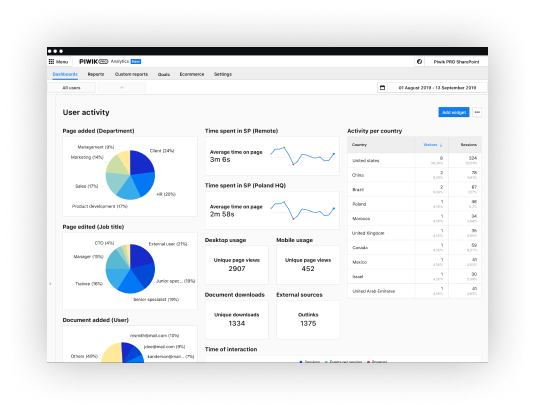Blog
Top Marketing Analytics Questions and Answers

Top Marketing Analytics Questions and Answers
In the era of digitization and big data, the role of analytics has become even more important to discover actionable market insights. Organizations hire marketing analysts to explore market trends, guide business strategies and procedures, and help leaders make more learned decisions.
The world of marketing is heavily dependent on data, from big global giants to national players, from mid-sized companies to small startups – everyone understands the need for data. Every citizen who uses the internet provides data in one form or the other, and this is the data that provides insights to businesses and helps them get closer to their customers.

As more companies depend on analytics for their marketing efforts, roles in the field of marketing analytics are plentiful, such as that of data analysts, marketing analysts, and web analysts.
So whether you are searching for a career in this booming field or someone who is preparing for an interview with an analytic firm, or you could be running in your own business and want to hire professional for your marketing plans, we have charted out few key questions that help you to understand the field better, its relevance, and its future.
Sorted by - Duration
So let us begin with our "Top marketing analytics questions and answers."
Q 1. "My company's revenue is growing, and my website traffic is increasing, so why should I get into the complexities of data analytics. Why do I need analytics?"
Answer: Analytics tells you what's working and what's not working on all aspects of your marketing, from content marketing to social media, to email marketing. It tells you if you are doing anything right or wrong.
Your business might be growing, but with the help of analytics and insights it provides, it's almost certain that you can grow more. With the help of analytics, you can find out the content your audience likes. You can identify which social media channels and activities drive the traffic to your site. Analytics, in many cases, provides large benefits; they give you the understanding to optimize your activities for yielding better results from such activities.
In short, marketing analytics can help:
-
Understanding target consumer
-
Monitoring business objectives
-
Evaluating the marketing performance
-
Analyzing the competition
Q 2. Are there any free analytic tools that one can use? If not, then what are the basic minimum number of tools that are needed?
Answer: Any social media team should at least be using the following analytic tools, which are also free to use:
Google Analytics: It tells you what traffic is coming and from where it is coming to your site. You can arrange goals and see landing pages, social networks, and what content is causing sales.
Google Alerts: Another free tool that allows you to track in the world of the web who is talking about your brand, and what are they taking?
Google AdWords: It is an online ad platform and pay-per-click search engine. Signing up for this tool allows you to access keyword planner. Identify top keywords and use them in your website, on your social media profiles, in your content, and everywhere to get desired SEO (Search Engine Optimization) results.
Google and Bing webmaster tools: These tools help you to optimize your site to get better SEOs.
Social Network Perform Analytics: Out of several contents you publish online, they show you the content your target audience is more, thereby providing you the lead to publish more of such content.
Above and several other online tools are available for free. While they are all free and the list can add many more, however, the problem is that you will have to visit each tool separately to see your data. This brings us to our next question.
Q 3. When analytic tools are available for free, what is the need to pay?
Answer: There is a range of free analytic tools available, and they all do different things. As highlighted in the above question, while they are available for free, you will have to visit them independently to get your data.
So the answer to this question is that you pay for time and visibility. Paid tools reduce your efforts to scout for information at multiple places. Paid tools make it easier to connect dots. For example, tools like Hootsuite and Sprout Social display metrics published through them, this way, you can compare your content across various platforms.
Another example of a paid tool is Brand24 which provides a higher number of brand mentions than Google Alerts (free tool). This extra is essential.
Q 4. How to interpret and use marketing data?
Answer: One of the common encounters marketers face is a lack of knowledge and understanding on how to interpret and use marketing analytics for business growth.
For example, marketers may have the complete set of records of customers that opened their email marketing, visited their banner ads, saw their videos on social media platforms, and more. With limited understanding and its implications, marketers are unable to figure out the value of the data, how to use them, and how it can add to their business. They find it difficult to put this data to use, and with such limited knowledge, it is difficult to expect any changes in the marketing strategy.
An organized effort is an answer to this challenge. The marketing team and IT team need to team up and work in harmony. Once the efforts are coordinated, you will engage with your customers effectively in no time.
Q 5. The general belief is "the more the data is, the better we get to know the audience." How relevant is this theory?
Answer: Often, it is observed that a high volume of data leads to too many scattered pieces, and it becomes difficult to assemble them to draw meaningful results. Too many fields lead to varied information in excess, and eventually, this creates holes in the data. Most likely, you will come up with no or little inferences towards your customers' buying behavior.
Rather than collecting data and then deciding what needs to be done with it afterward, it is better first to define the goal post and then start collecting data.
You need to question yourself as a marketer:
-
Why do you need data?
-
In what time frame do you need the data?
-
What do you expect data to provide you?
It makes sense to start data gathering once you have answers to the above questions.
Q 6. How to identify the tool or set of tools required for the business?
Answer: Today, there are hundreds of marketing analytic tools which are available. Hence the challenge is which one to choose out of the many available.
Since each tool provides a unique set of features to solve different needs, a clear understanding of all marketing analytics tools is necessary. If marketers don't do an in-depth study about the tool they want to use, you may end up gathering data that you wouldn't know how to use.
The solution to this lies in understanding your business objectives. Once objectives are clearly defined, you may set aside budgets and narrow down the list of analytics tools you need. Pick such tools which meet your Let your marketing team perform tasks more effectively.
Q 7: Which are the three biggest marketing analytics challenges business faces?
Answer: The three most significant challenges are
Data Boom: It is estimated that nearly 2.5 quintillion bytes of data get created every day, and it is likely to double in the next 2 years. This explosion of data can be critical if marketers do not know how to utilize them.
Fast-changing trends: In 2018, did anyone imagine how the world would start shaping up from the last quarter of 2019? How will the whole of 2020 struggle to survive, and how in 2021 are we still struggling? Consumer preferences in the last one and a half years have changed drastically. It is not easy to keep pace with the ever-evolving business environment.
The right flair: Having the right pool of talent in marketing analytics is a big challenge. Not just hiring the right talent, maintaining pace with the ever-evolving technology is daunting. It is essential to not only have skilled people in the team but also they need to have the right attitude. Ways to address this challenge are:
-
Realign your current resources.
-
Hire new talent
-
Work with specialist firms in the field of marketing analytics.
Final Thoughts
The key here is to understand the marketing analytics challenges that marketers face. It helps them to design data-driven marketing strategies. What you require in terms of analytics tools is dependent on the social network you market on, the volume of marketing you engage with, customer service requirements, and several other factors. You need to start by optimizing your site's SEO, reading reports, identifying the emerging patterns, and other related questions. Chief Marketing Officers (CMOs) need to understand their marketing analytics function to determine how to gain in a data-first world.